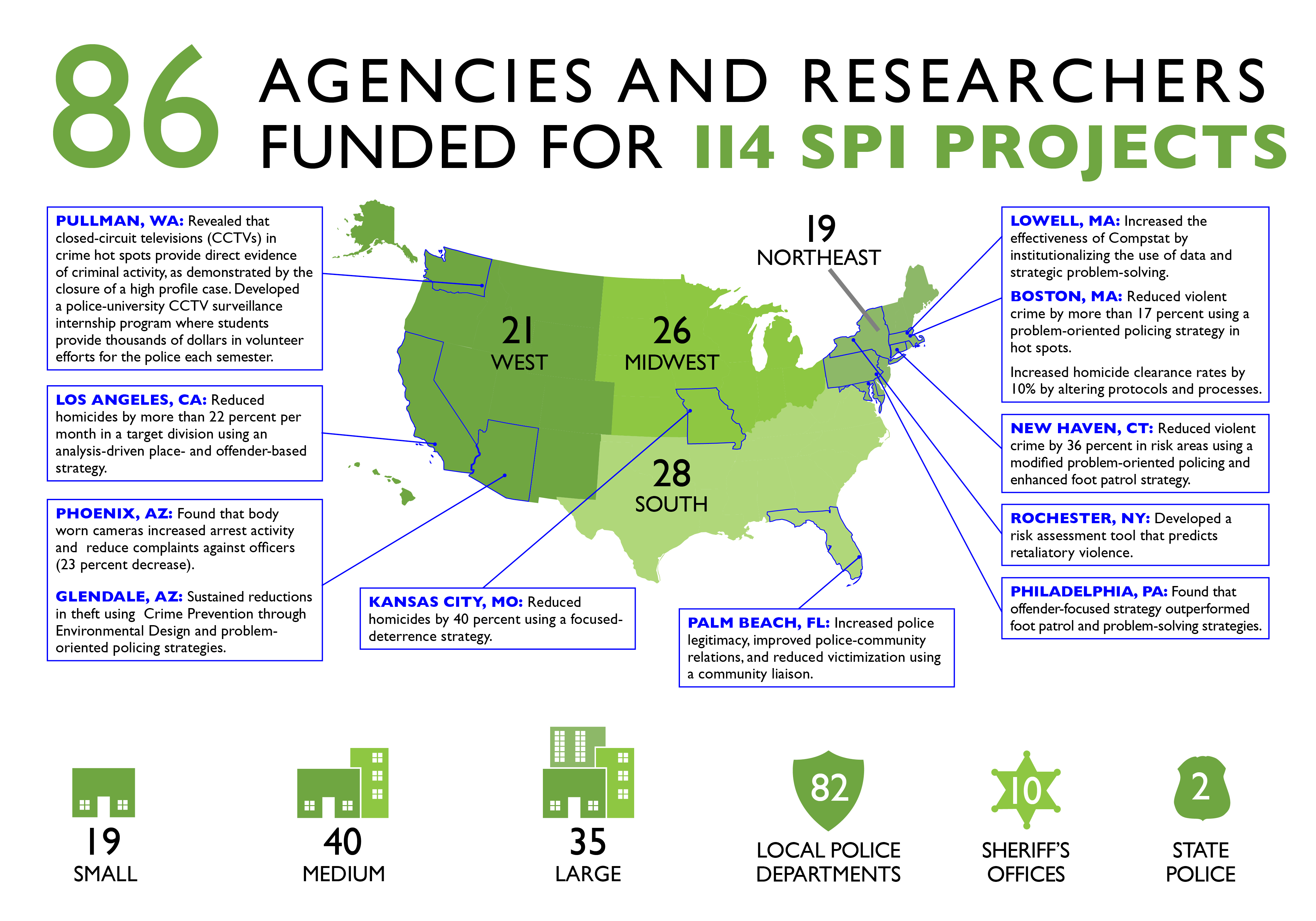SPI Findings
SPI Findings
| Site | Implementation | Research Design & Findings | Topic |
|---|---|---|---|
| Philadelphia, PA2009 | The Philadelphia SPI tested the impacts of three police strategies in violent crime hotspots (foot patrols, POP, offender-focused policing).
| Research Design Process and outcome evaluation of the randomized control design FindingsOffender-focused strategy outperformed foot patrol and problem-solving strategies. Compared to the control areas, the treatment areas that received the offender-focused strategy experienced a 22% decrease in violent crime, and a 31% decrease in violent street felonies. | Violence Reduction |
| Phoenix, AZ2011 | The Phoenix SPI aimed to improve relations with minority communities by developing a body-worn camera (BWC) program.
| Research Design Process and outcome evaluation, pre- and post- deployment FindingsFrom pre- to post-deployment, officers with BWCs experienced a 22.5 percent decline in officially recorded complaints, while across all other precincts there was a 45.1 percent increase in complaints. | Technology |
| Phoenix, AZ2015 | This SPI tested the effects of body-worn camera in the six Phoenix Police Department (PPD) precincts through a randomized control trial including activation, and officer perceptions. | Research Design The research team randomly selected officers to wear a BWC from the pool of 467 officers who provided consent. The evaluation relied on BWC metadata automatically generated by camera activation, official police computer-aided dispatch (CAD) data, official arrest data, official use of force reports, and citizen complaints reported to the PPD. Findings
| Body-Worn Cameras |
| Pinellas County, FL2013 | The SPI developed a Mental Health Unit (MHU) within the Pinellas County Sheriff's Office (PSCO). The MHU unit consisted of two mental health clinicians (Navigators) and up to four certified law enforcement deputies. The strategy allowed MHU deputies to coordinate a quasi-mobile crisis response with the Navigators. The Navigators regularly reviewed PCSO calls for service and record management systems to determine if specific subjects of mental health calls could benefit from additional follow-up or if a known subject has had recent PCSO contact. Navigators also provided intensive case management to PCSO’s identified consumers to help ensure that their mental and behavioral health needs were met in an effort to reduce their subsequent law enforcement contacts. | Research Design This project evaluation included process evaluation methods that were designed to describe the activities of and individuals served by the Pinellas County Sherriff’s Office (PCSO) Mental Health Unit (MHU), and it also included outcome evaluation methods designed to assess the effectiveness of the MHU. Findings
| Mental Health |
| Portland, OR2014 | Through a multi-agency, collaborative effort, the Portland Police Bureau (PPB) worked in coordination with the Mayor’s Office, local academics, and community partners to reduce crime and build community relationships primarily through community engagement patrols (CEP). | Research Design Ninety high crime areas were randomly assigned to receive none, two, or four 15-minute supplemental CEPs a day for a three month period. Offense reports, CAD data, resident surveys, officer focus groups, and officer surveys were used to conduct process and outcome evaluations of the NI-Loc program. Findings
| Community Engagement |
| Roanoke County, VA2015 | The SPI evaluated the effects of mobile crisis team in an experimental context to enhance police response to people with mental illness. The intervention sought to understand and improve Roanoke County Police Department's response to calls for service (CFS) involving individuals experiencing mental health (MH) crises in Virginia’s primarily rural Roanoke Valley. | Research Design An experimental intervention testing the efficacy of a police-mental health provider co-responder model for addressing mental health-related calls for service. Findings
| Mental Health |
| Rochester, NY2012 | The Rochester SPI intervened in retaliatory gun violence.
| Research Design Examination of descriptive statistics, correlation coefficients, and logistic regression models. FindingsThe evaluation validated the risk assessment tool as a predictive device: for every one-point increase in the assessment tool score that a dispute received, the odds of violence occurring in that dispute over time increase by 29%. | Gun Violence, Violence Reduction |
| Sacramento County, CA2016 | The Sacramento SPI implemented a Homeless Outreach Team (HOT). The overall objective of the SPI-HOT pilot was to develop a new service & community-oriented policing approach for addressing homelessness that de-emphasizes enforcement strategies. Three part-time deputies collaborated with various social services to provide street outreach services to individuals and families experiencing homelessness in select “hot spots” of the county – areas identified by Sheriff’s analysts and the research partner as having high levels of homelessness. | Research Design The intervention was intentioned to result in a series of staggered short-term and intermediate outcomes that would over time contribute to increase safety and collective efficacy in the community around issues of homelessness (the long-term impacts). The evaluation also conducted a process evaluation on implementation of HOT. Findings
| Community Engagement, Homelessness |
| Savannah, GA2009 | The Savannah SPI addressed increases in violent crime rates through the Savannah Impact Project (SIP), an intensive reentry and monitoring program focused on high-risk offenders.
| Research Design Pre-post impact analysis, assessment of service provision Findings16% reduction in violent crime at the Central Precinct (target area). Exploratory analyses found that providing services could reduce the likelihood of future crimes. Interviews concluded that SIP was effective because of the multi-agency collaboration and ability to balance treatment and enforcement approaches. | Violence Reduction |
| Shoreline, WA2015 | This SPI developed the Response Awareness, De-Escalation, and Referral (RADAR) effort that was aimed to institutionalize department-wide and regional information sharing about community members with behavioral health issues or developmental disabilities (BH/DD) who may be at increased risk of violence or use of force; and offer opportunities for outreach and connection to services and resources through a mental health “navigator.” | Research Design A quasiexperimental design based on propensity score matching (PSM) methods in which RADAR response plan recipients would be matched with similarly-situated people in a comparison jurisdiction to compare outcomes accompanied by a process evaluation. Findings
| Mental Health |

